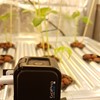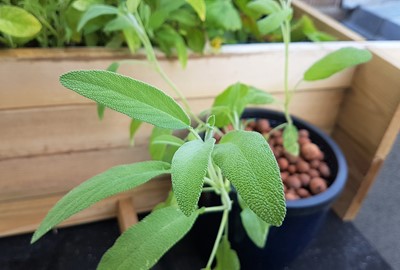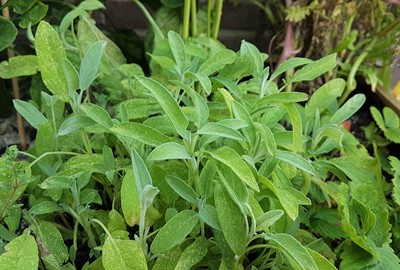Description
The Salvia Officinalis is one of the best known sage species. Sage originates from the countries in the Balkans and around the Mediterranean Sea. It is, just like rosemary, thyme and oregano, a very famous herb. You might have to take care of the amount you use, because of it's strong and spicy Mediterranean flavor. The leaves are regularly found in recipes, fried or baked in butter and then on a pasta, or used for the well-known Saltimbocca, but it is also used in sauces, with meat like lamb and pig.
The lower part of the plant has woody branches, with on top of that the gray-green hairy stems with gray to gray-green leaves. Some species do not blossom, although other species, like the Salvia Officinalis bloom very rich (often around the end of spring and / or early summer), with flowers that can be either white, pink, lilac or purple. Also those flowers are edible. I've never seen my sage bloom, because I trim it all the time for leaf growth.
Cultivation
Salvia Officinalis can grow about 30 to 40 centimeters high. My experience is that it's more efficiënt to keep the plant low but quite wide to grow more leaves. It is also useful to take this into account for planting, because sage does not like to move or be repotted.
The Salvia Officinalis is a short-lived plant, and will die after a severe or wet winter outside. However, she could survive the winter when the soil stays dry. Frost after a rainy day is more dangerous for her than frost while the roots are in relatively dry soil. Inside, she can live for 3, 4 or 5 years when taken good care of.
If you want to sow sage, do so preferably in early spring. Put the seeds on a mixture of potting soil and about 1/5th or 1/6th part of vermiculite or perlite. Then cover the seeds with only a thin layer of vermiculite or perlite. Of course, you need to keep an eye on the seedlings, you should water regularly (I do so once a day), as seeds that dry out during germination will die. At room temperature seeds germinate within 1 to 3 weeks. After germination you should water a little less often. Sage, especially as a seedling, holds a light-moist soil and when she's mature she can live on dry soil.
Sage is a Mediterranean plant, so you can already imagine what climate is associated with her and what it would like to find. A sunny and warm place will do the magic.

 Thomas East
Thomas East


